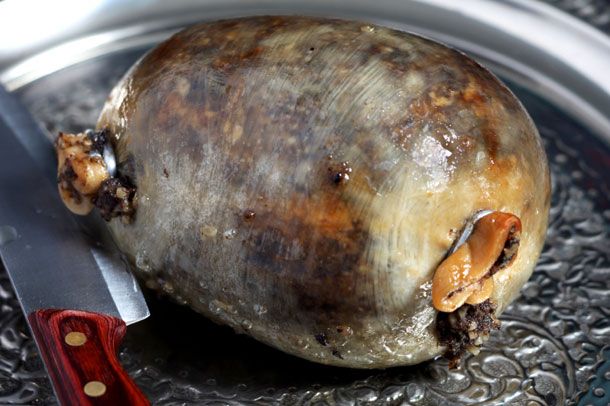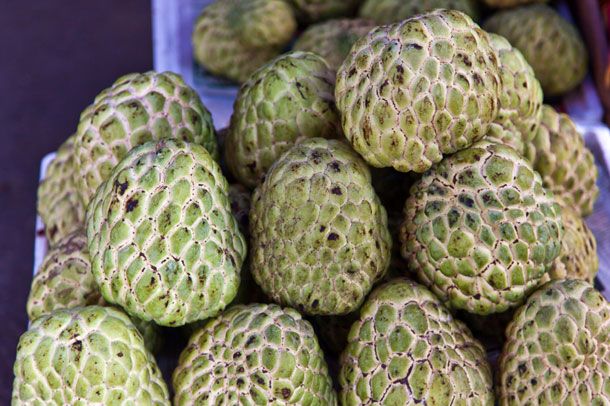Last week, we all joined in helping California mourn the impending loss of foie gras owing to a statewide ban. This got us thinking about all the other banned and impossible-to-find foods here in the U.S., and how, as dutiful food writers, we’d like to try them all someday. Surprisingly, things like blowfish, shark fin, and horse meat (see this bologna M. Wells recently served on a grilled cheese, with foie gras, too) are still legal. (California just outlawed shark fin last year, though people can still sell it there until July 2013.) Okay, Grub Street draws the line at human genitalia, but what’s wrong with some real, non-canned Scottish haggis? Check out all the food that’s banned, but shouldn’t be, straight ahead.
These small, ultraflavorful plums are a specialty of Lorraine, France, and can be found occasionally in England and elsewhere, but never in the U.S. because of import restrictions on fresh produce.
Pig’s blood cake on a stick — sort of like British black pudding — is a street-food staple in Taiwan. Customs wouldn’t look kindly on you trying to bring this stuff back here, and a rumor that the USDA had banned the production of pork blood cake altogether in the U.S. sent shockwaves through Taiwan. But the rumor
turned out to be unfounded (though you still can’t import it), and Taiwanese restaurants in the San Gabriel Valley near L.A. occasionally serve versions of it. Industrious food-cart operators should take note! This could be a hot trend for 2013.
Raw milk has become
a cause for major crackdowns in L.A., and perhaps with good reason — at least ten people
got sick from a bacteria found in raw milk last month from a Fresno County dairy. Still, unpasteurized butter tastes really good, and raw foodists still insist that raw milk is way better for you than that pasteurized, bacteria-free stuff.
Photo: TIM SLOAN/2008 AFP
These German candies, also known as Kinder Eggs, are chocolate shells with toys inside. Apparently choking hazards aren’t that big a deal in Germany. The kids should know better, basically.
Once a delicacy among the British aristocracy, swans have become taboo food in England and the U.S. In this country, several swan species, including mute and trumpeter swans, are protected and endangered, and in England, since Elizabethan times, all swans have been “owned” by the royal family and therefore protected.
Photo: STRINGER/2006 AFP
Sure, lots of chefs are making great salumis in the States now. But there’s nothing like the real thing from a salumeria in Italy. Good luck getting that stuff through Customs.
So pretty, isn’t it? Commercial haggis is just like sausage these days, but real Scottish haggis, which you’ll never see here, is a savory pudding made from sheep offal that’s been stuffed and simmered inside the sheep’s stomach. A ban in the U.S., dating back to 1971, pertains to the fact that real haggis contains sheep lungs, which are not allowed to be imported.
These fruits, similar to lychees, are native to Southeast Asia and hard to come by on our shores, again owing to import restrictions.
Jackfruits are not technically banned outright, but they have to be imported and irradiated, and some markets won’t even sell irradiated fruit, so they tend to be hard to find at best. The giant fruit found in Jamaica, Thailand, and elsewhere in tropical climes are apparently very sweet and delicious, but we cannot say because we’ve never tried it.
In order to pass muster with the USDA, imported cheeses made from raw milk have to be aged for 60 days or more, to let any potentially harmful bacteria die off. But honest-to-Dieu camembert should only be aged 30 days, and that stuff is illegal here — but
CHOW claims that it’s easy to get by mail order and some cheesemongers carry plenty of the less-aged stuff, which just has fibs about its age on its labels. We will, however, draw the line at
cazu marzu, a raw cheese from Sardinia that contains live maggots.
Photo: FABRICE COFFRINI/2011 AFP
Feldsalat, or field salad, is a vitamin-rich, aromatic ground-cover that’s frost-resistant and has been traditionally used in Germany in place of lettuce in the colder months. Also known as rampion or rapunzel, it figures in
the Grimm’s fairy tale of that name because it was a craving for the plant that led to Rapunzel’s mother having to give her up to the witch next door, who put her in that tower. So obviously it must be delicious. It’s not something you can ever find in a market here, but it is commonally available across Europe.
Photo: Sieglinde Bauknecht
A common and popular fruit in Mexico and Colombia, guanabana doesn’t really grow here and isn’t found often as an import. Also known as soursop, the guanabana’s flavor is described as being some combination of strawberry and pineapple with a citrus tartness.
Anthony Bourdain, of course,
has had it. Former French President François Mitterrand requested it for a final feast shortly before he died, on New Year’s Eve 1995. The tiny, endangered, two-ounce songbird is a coveted delicacy of the French aristocracy dating back to Roman times and is said to represent “the French soul.” Before being eaten, the birds were blinded and fattened in a cage on a diet of millet and then drowned in a bowl of Armagnac. They’re then supposed to be roasted and eaten whole, tiny bones and all, just biting off the head and beak and letting it fall into a napkin. (Mitterand is said to have performed the traditional ritual of covering his head with a white cloth to eat his ortolan so that God could not see him doing it.) Bourdain described the experience of eating ortolan thusly: “There’s a vestigal flavor of Armagnac, low-hanging fumes of airborne fat particles, an intoxicating delicious miasma. … I bring my molars down and through my bird’s rib cage with a wet crunch and am rewarded with a scalding hot rush of burning fat and guts down my throat. Rarely have pain and delight combined so well. … With every bite, as the thin bones and layers of fat, meat, skin, and organs compact in on themselves, there are sublime dribbles of varied and wonderous ancient flavors: figs, Armagnac, dark flesh slightly infused with the salty taste of my own blood as my mouth is pricked by the sharp bones.” Yum?


















